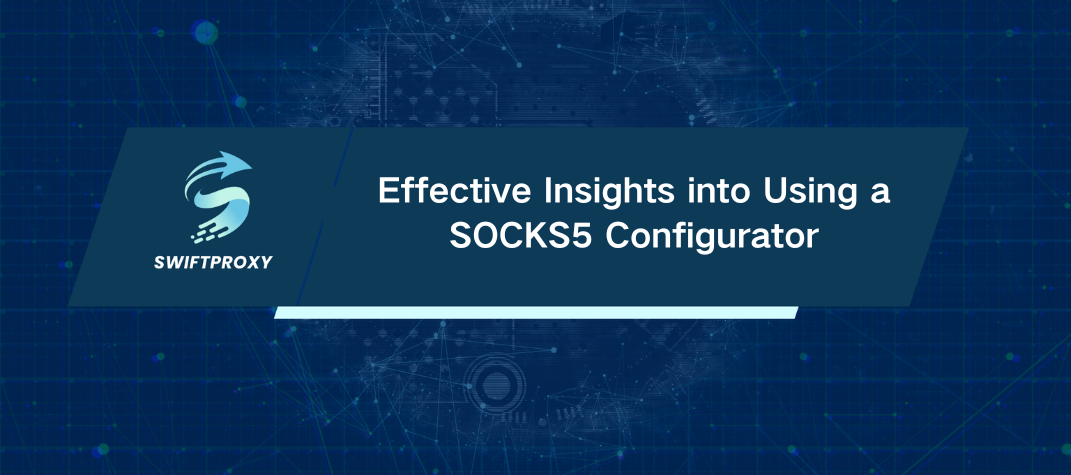Effective Insights into Using a SOCKS5 Configurator

When it comes to network security, the choices we make can significantly impact our privacy and data integrity. A staggering 70% of data breaches occur due to weak network security. If you want to bolster your protection, using a SOCKS5 proxy configurator is a wise choice. Let's dive into the essentials of getting started and optimizing your SOCKS5 setup, ensuring you're not just safe but also making the most of your proxy experience.
1. Understanding SOCKS5 Proxy
SOCKS5 is more than just a network protocol; it's your gateway to secure and versatile data exchanges between clients and servers. Unlike typical HTTP proxies, SOCKS5 supports various data transmission types, including both TCP and UDP. This capability translates to enhanced security and authentication, making it a preferred option for safeguarding user privacy and circumventing network restrictions.
2. Getting Started with SOCKS5 Proxy Configuration
Ready to get going? Here's a streamlined guide to set up your SOCKS5 proxy quickly:
Select a Reliable SOCKS5 Proxy Provider
Your first step is to select a trustworthy SOCKS5 proxy service. Evaluate providers based on server locations, speeds, and pricing. Choose one that aligns with your needs, ensuring reliability and performance.
Get and Install the Configurator
Most providers offer dedicated configurator software to simplify the setup process. Head to your chosen provider's website and download the software that's compatible with your operating system. Follow the installation prompts—it's usually straightforward.
Set Up Your Proxy Settings
Now, it's time to configure your settings. SOCKS5 proxy configurators typically feature user-friendly interfaces or configuration files. Enter the server address, port number, and any required authentication details, such as your username and password. Once entered, save your settings.
3. Enhanced Configuration Settings
Once you have the basics down, it’s time to explore advanced settings that can enhance performance and security:
Security and Encryption Choices
Many configurators allow you to encrypt your communications. Opt for protocols like TLS/SSL to ensure your data remains confidential and intact during transmission. This is crucial in an age where data breaches are all too common.
Bind Local Addresses
This option lets you bind the proxy to a specific local IP address and port. Why does this matter? It allows you to control local access and listening settings, tailoring the proxy to your environment.
Manage and Control Traffic
Fine-tune your proxy's performance with traffic management features. Limit bandwidth, set connection timeouts, and adjust the maximum number of concurrent connections. These adjustments can significantly improve your network's stability.
Debugging and Protocol Support Features
Depending on your needs, check if the configurator supports different protocols and debugging tools. This feature can be invaluable for troubleshooting connection issues, giving you detailed logs to work with.
4. Practical Applications and Use Cases
Overcoming Geographical Barriers
In some regions, access to specific websites may be restricted. With a SOCKS5 proxy, you can change your IP address, making it appear as if you’re browsing from a different location. This capability opens doors to blocked content.
Enhancing Network Security and Privacy
Whether for individual users or enterprises, SOCKS5 proxies act as intermediaries, masking your real IP address and network activity. This helps prevent third-party tracking and enhances your overall security posture.
5. Best Practices and Recommendations
As you configure and use your SOCKS5 proxy, keep these key points in mind:
Find a Reliable Service Provider: Research and select a provider with a solid reputation for stability and service quality.
Ensure Strong Security Protocols: Use encrypted communication methods and regularly update your authentication details to safeguard your data.
Abide by Local Laws: Ensure your proxy usage adheres to local regulations and service terms. This can save you from potential legal troubles down the road.
By taking the time to understand and optimize your SOCKS5 proxy configuration, you not only enhance your online security but also unlock a host of opportunities for seamless browsing. With the right setup, you can navigate the digital world confidently.

















































